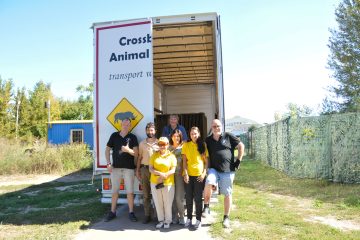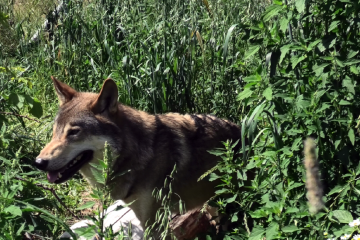(revised 2018; annotated 2020)
1
A wildlife rehabilitator should strive to achieve high standards of animal care through knowledge and an understanding of the field. Individuals must make an effort to be informed of current rehabilitation information, methods, and regulations through participation in continuing education.
Wildlife rehabilitators need to strive to continually improve their techniques and learn from each other how to best help their wildlife patients.
2
A wildlife rehabilitator should be responsible, conscientious, and dedicated, and should continuously work toward improving the quality of care given to wild animals undergoing rehabilitation.
All wildlife rehabilitators are dedicated. When taking responsibility for the care of wild animals, it is their obligation to act responsibly and conscientiously. Rehabilitators owe it to both the animal and the person who found the animal to be as conscientious about the quality of care they are providing as they are dedicated to providing it.
3
A wildlife rehabilitator must abide by local, state, provincial, and federal laws concerning wildlife, wildlife rehabilitation, and associated activities.
Wildlife rehabilitators must abide by the laws concerning wildlife. Wildlife rehabilitators should read their permits; know the local regulations regarding rabies vector species, >nonnative species, and “nuisance” wildlife; and know their legal obligations and limitations. If wildlife rehabilitators do not do this, they reflect poorly on themselves and on their profession, and they demonstrate that they lack ethics or any regard for ethics. This statement also includes the phrase “and associated activities.” Wildlife rehabilitators must abide by local, state, and federal laws while doing anything in conjunction with rehabilitation, including seeking donations, conducting any business activities, educating the public, constructing enclosures or buildings, disposing of animal wastes and remains, etc.
4
A wildlife rehabilitator should establish safe work habits and conditions, abiding by current health and safety practices at all times.
In the case of centers or clinics with paid staff, this statement is the law (regulated by the Occupational Safety and Health Administration in the US), but for most rehabilitators, it is just good sense. Wildlife rehabilitators should keep their work environments safe—for themselves, for their volunteers, and for the animals. Wildlife rehabilitators need to train themselves to think like the animals in their care, anticipate how they might injure themselves in their housing, and make any necessary changes to avoid those injuries. Diseases can be easily spread in captivity—between animals, from animals to humans, from humans to animals, and from patients back into wild populations.
5
A wildlife rehabilitator should acknowledge limitations and enlist the assistance of a veterinarian or other trained professional when appropriate.
This item can be difficult to follow; it isn’t easy for anyone to acknowledge personal limitations. Many people seem to be afraid to say “I don’t know” or to ask for help. However, admitting they don’t know and asking for help are the best ways to learn and usually result in the best care for the animals. Wildlife rehabilitation is still a relatively new field and involves many species. Little is known about the appropriate housing and feeding of many species, let alone their various diseases, metabolic pathways, responses to medications, and methods of healing. Veterinarians do not have all the answers. In fact, when it comes to wildlife, many veterinarians have very few of the answers and often should be asking more questions. In regard to medical problems with the animals, veterinarians may have answers or can provide specialized skills. However, other trained professionals, including state biologists, zoo nutritionists, pathologists, ornithologists, and naturalists also can be of great assistance. These individuals may include anyone with the experience and expertise to help the rehabilitator find the information needed. One of the most important resources to new rehabilitators is other wildlife rehabilitators. Even though a wildlife rehabilitator may not agree with everything another rehabilitator does, everyone has things that they do very well, or that work well for certain animals in certain circumstances. Wildlife rehabilitators should make inquiries of others, share information, and use personal judgment as to what methods and procedures will work best for a particular situation. State and national organizations provide the means for easy access to networking. Asking, searching, and networking are well worth the time and effort, as the end result will be better care for wildlife patients.
6
A wildlife rehabilitator should respect other rehabilitators and persons in related fields, sharing skills and knowledge in the spirit of cooperation for the welfare of the animals.
As stated before, a rehabilitator should share skills and knowledge. This can range from sharing information via a simple phone call or a conversation with one person, via a group chat on the internet, or through printed articles and presentations at the local, national, or international level. Wildlife rehabilitators may not always agree with their colleagues in rehabilitation or related fields, but they should remember to respect others’ opinions. Their experiences will be different; consequently, their perspectives will be different.
7
A wildlife rehabilitator should place optimum animal care above personal gain.
Wildlife rehabilitators need to make sure that their egos do not interfere with patient welfare. Balance the knowledge, or even the feeling, of success gained in attempting to treat an animal with the impact the treatment process may have on the animal. It is exciting to receive a rare and seldom-treated species, and it may be desirable to be the one individual who finally succeeds in rehabilitating that species to the point of return to the wild. However, it is a moral obligation to that animal and to the profession to transfer the animal to another’s care if the facility or one’s medical ability is not suited to the needs of that species and another facility/individual can provide that animal with a better chance of survival.
8
A wildlife rehabilitator should strive to provide professional and humane care in all phases of wildlife rehabilitation, protecting the welfare, respecting the wildness, and maintaining the dignity of each animal in life and in death. Releasable animals should be maintained in a wild condition and released into habitat suitable for that species as soon as appropriate. Nonreleasable animals have a right to euthanasia.
Previous items concluded that wildlife rehabilitators should strive to provide the best care for their wildlife patients. This item takes this concept a step further. It states that wildlife rehabilitators should provide care with respect and maintain the dignity of the animal. All life—human, animal, or otherwise—does deserve respect. And the comfort, welfare, and dignity of that life must be considered throughout the rehabilitation process. An animal is not helped if it is habituated to or imprinted on humans, or kept in physically and/or psychologically uncomfortable or unhealthy situations. If wildlife rehabilitators cannot ensure that an animal will have dignity in its life, they can provide it with dignity in its death. Although release to the wild is the desired outcome for wildlife rehabilitation efforts, euthanizing a nonreleasable animal that will not adapt well to captivity because of its injuries and/or temperament is an appropriate and humane outcome for that patient.
9
A wildlife rehabilitator should encourage community support and involvement through volunteer training and public education. The common goal should be to promote a responsible concern for living beings and the welfare of the environment.
Wildlife rehabilitators’ work can be far reaching, if time is taken to reach out. Simple ways to share knowledge with the public include individual conversations with rescuers, talks to school groups, and articles in the newspaper or on social media. Unlimited opportunities exist to teach and influence many people.
10
A wildlife rehabilitator should work on the basis of sound ecological principles, incorporating appropriate conservation ethics and an attitude of stewardship.
Wildlife rehabilitators need to respect the ideas and opinions of their colleagues in wildlife biology. Although wildlife rehabilitators usually focus on the individual, they should remain open to the views of those focusing on wildlife populations. If wildlife rehabilitators are open to understanding the issues and value of population biology, wildlife biologists will be more open to remembering that populations are made up of individuals. Remember that caring for individual animals is only part of wildlife rehabilitation. To truly care for the animal, everyone must also care for the environment—this includes avoiding the introduction of disease into wild populations, avoiding the creation of “nuisance wildlife” situations and/or public harm, and respecting wildlife laws and the reasons for them.
11
A wildlife rehabilitator should conduct all business, activities, and communications in a professional manner, with honesty, integrity, compassion, and commitment, realizing that an individual’s conduct reflects on the entire field of wildlife rehabilitation.
“A professional manner” means working and interacting with others with honesty, integrity, compassion, and commitment. If wildlife rehabilitators do these things, they are truly professionals. When wildlife rehabilitators conduct themselves in a professional manner, they can take pride in who they are and what they do, and will gain trust, respect, and credibility that enables them to do even more for wildlife. With social media, communicating in a professional manner becomes extremely important. Electronic images of wildlife rehabilitation can convey messages to a large number of people in a very short time, and that information needs to be positive and professional. Photos, videos, and other media should be evaluated closely for suitability for public sharing.
Miller, E. A., and J. Schlieps, editors. 2021. Standards for Wildlife Rehabilitation. National Wildlife Rehabilitators Association: Bloomington, MN. 419 pages.


